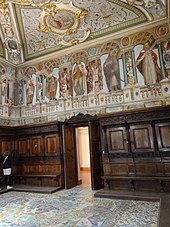Cava de 'Tirreni Abbey
| Cava de 'Tirreni Abbey | |
| Basic data | |
|---|---|
| Country | Italy |
| Church region | Campania |
| Ecclesiastical province | Salerno-Campagna-Acerno |
| Metropolitan bishopric | Archdiocese of Salerno-Campagna-Acerno |
| Dept | Michele Petruzzelli OSB |
| Dept. Emeritus | Benedetto Maria Salvatore Chianetta OSB |
| founding | 1394 |
| surface | 1 km² |
| Parishes | 1 (2016 / AP 2017 ) |
| Residents | 20 (2016 / AP 2017 ) |
| Catholics | 20 (2016 / AP 2017 ) |
| proportion of | 100% |
| Religious priest | 4 (2016 / AP 2017 ) |
| Catholics per priest | 5 |
| Friars | 7 (2016 / AP 2017 ) |
| rite | Roman rite |
| Liturgical language | Italian |
| cathedral | Santissima Trinità |
| address | Via Morcaldi 5 84010 Badia di Cava [Salerno] Italia |
| Website | http://www.badiadicava.it |
The Territorial Abbey of the Most Holy Trinity of Cava de 'Tirreni ( Latin Abbatia Territorialis Sanctissimae Trinitatis Cavensis , Italian Abbazia territoriale della Santissima Trinità di Cava de' Tirreni ) is an exemte Benedictine abbey in Campania in the province of Salerno . It is also known under the name Badia di Cava , as it is located below a grotto.
The monastery is located on a hill about three kilometers from the town of Cava de 'Tirreni , for which the abbey was the starting point of development, and not far from the Amalfi Coast .
history
The abbey was founded around 1020 by the Salernitan aristocrat Alferio Pappacarbone , a Longobard trained in the Cluny Abbey , who retired to a hermit life below the Arsiccia cave in 1011 . His holy life attracted numerous students who built a small monastery, the core of what is now the abbey. St. Alferio died in old age on April 12, 1050.
The first four abbots of Santissima Trinità have been recognized as saints by the Church ( Alferio , Leone , Pietro and Costabile ), others were beatified ( Simeone , Falcone , Marino , Benincasa , Pietro II , Balsamo , Leonardo , Leone II ).
Among them is San Pietro I. , nephew of Alferio emphasized, which expanded the monastery very strong and a monastic cloister Association founded the Ordo Cavensis that spread over the whole of southern Italy. The expansion was supported by the princes of Salerno. San Pietro accepted more than 3000 monks into the community. Pope Urban II , who met San Pietro in Cluny, visited the abbey in 1092 and consecrated the basilica . As early as 1100, the monastery finally received the exemption from the episcopal authority.
Princes and nobles gave the abbey extensive rights, goods and patronage rights to many churches and monasteries. The Popes confirmed the donations and in 1394 Boniface IX raised. the already exemte Benedictine monastery to the abbey bishopric . The pontiff gave the settlement around the monastery the title of a city , the territory of which became the territory of the new diocese . The Abbot Bishop of Cava had to reside in the monastery, and the abbey church has served as a cathedral ever since . The monastic community formed the chapter of the episcopal church.
Nevertheless, the monastery experienced in the 14th – 15th centuries. Century declined and like many other monasteries was led by commendatabbots .
1426 Mgr. Angelotto Fosco , later cardinal, the first commander abbot to rule the monastery and abbey diocese.
The last Commendatarabb gave the abbey to the Congregation of Saint Justina of Padua around 1500 . The reforms no longer place a bishop or cardinal at the head of the abbey , but a temporary abbot . The spiritual life of the abbey flourished again from the 16th century and the church was also architecturally renovated. Abbot Giulio De Palma had the church, seminary, novitiate and other parts of the monastery rebuilt.
The abbey was abolished under Napoleon , whereby Abbot Carlo Mazzacane was able to prevent major damage. The 25 monks remained on the site under his direction. With the restoration after the fall of Napoleon, the abbey was brought back to spiritual life. In the 19th century, the monastery community participated in the establishment of a Benedictine settlement in Australia, the New Norcia Abbey .
With the abolition of the monasteries by the law of July 7th, 1867, the abbey was declared a "Monumento Nazionale" and entrusted to the monastic community, who were able to prevent destruction by the abolition.
The current territorial abbey (abbey diocese) comprises four parishes and the churches of Maria Santissima Avvocata above Maiori , Avvocatella in San Cesareo and San Vincenzo Ferreri in Dragonea.
The famous monastery archive contains around 15,000 documents from the 8th century. The library holds many important manuscripts and incunabula and is one of the most important cultural institutions in southern Italy.
Boarding school and school
In 1867 a boarding school (the Collegio "San Benedetto" ) with a school was set up in the monastery . The Liceo Classico has been on an equal footing with state schools since 1894 and is also open to home sleepers. Since 1985 the school has also been open to women.
See also
literature
- Mariano Dell'Omo: Art. La Cava , in: LThK , 3rd ed., Vol. 6, Freiburg 1997, Sp. 565f
Web links
- Entry on Cava de 'Tirreni Abbey on catholic-hierarchy.org (English)
- www.badiadicava.it (Official website of the abbey)
- www.newadvent.org (English)
- www.avvocatella.it (Italian)



